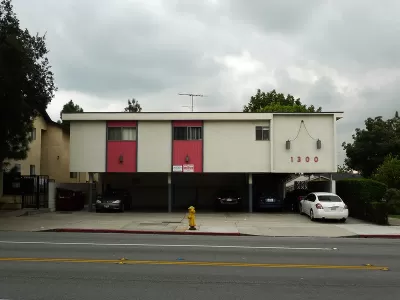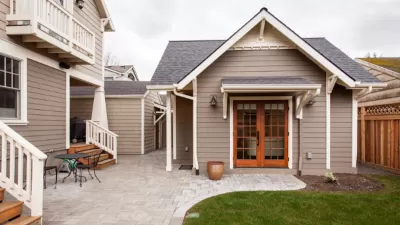The low-slung, car-oriented apartment buildings represent a mid-century solution to a housing shortage and offer valuable lessons for new development.

Describing the "aggressively economical" icon of mid-density apartment buildings known as dingbats that pepper Los Angeles from the Valley to the Eastside, Laura Bliss writes that these buildings "were a multifamily answer to that single-family template." These two- to three-story buildings include a carport on the bottom level and generally house six to 12 units. In the 1950s and 1960s, "[t]his new format for affordable multifamily living became nearly as ubiquitous as the single-family tract housing that iconified the much-mythologized Southern California suburban lifestyle."
Dingbats provided "an essential resource for a growing city: Los Angeles County added more than three million residents between 1940 and 1960, thanks to job booms in manufacturing and aerospace, educational opportunities for returning GIs, and the lure of year-round sunshine." Over 700,000 new units sprawled outward as new freeways made the periphery more accessible and the city swallowed up citrus orchards and ranches.
Today, dingbats, many of which are rent-stabilized, offer some important benefits as "a bastion of relatively affordable shelter" in a city facing a severe housing shortage. "Dingbats may also hold the possibility for accommodating further infill: Thanks to recent legal changes, it’s now possible to convert carports into accessory dwelling units, which some owners are beginning to do." These buildings exemplify the mid-century's answer to "missing middle housing" and "tell a story of when the city met the demands of the day with a low-cost, replicable, yet individualized housing form factor."
FULL STORY: How Los Angeles Became the City of Dingbats

Trump Administration Could Effectively End Housing Voucher Program
Federal officials are eyeing major cuts to the Section 8 program that helps millions of low-income households pay rent.

Planetizen Federal Action Tracker
A weekly monitor of how Trump’s orders and actions are impacting planners and planning in America.

Ken Jennings Launches Transit Web Series
The Jeopardy champ wants you to ride public transit.

California Invests Additional $5M in Electric School Buses
The state wants to electrify all of its school bus fleets by 2035.

Austin Launches $2M Homelessness Prevention Fund
A new grant program from the city’s Homeless Strategy Office will fund rental assistance and supportive services.

Alabama School Forestry Initiative Brings Trees to Schoolyards
Trees can improve physical and mental health for students and commnity members.
Urban Design for Planners 1: Software Tools
This six-course series explores essential urban design concepts using open source software and equips planners with the tools they need to participate fully in the urban design process.
Planning for Universal Design
Learn the tools for implementing Universal Design in planning regulations.
Ada County Highway District
Clanton & Associates, Inc.
Jessamine County Fiscal Court
Institute for Housing and Urban Development Studies (IHS)
City of Grandview
Harvard GSD Executive Education
Toledo-Lucas County Plan Commissions
Salt Lake City
NYU Wagner Graduate School of Public Service





























